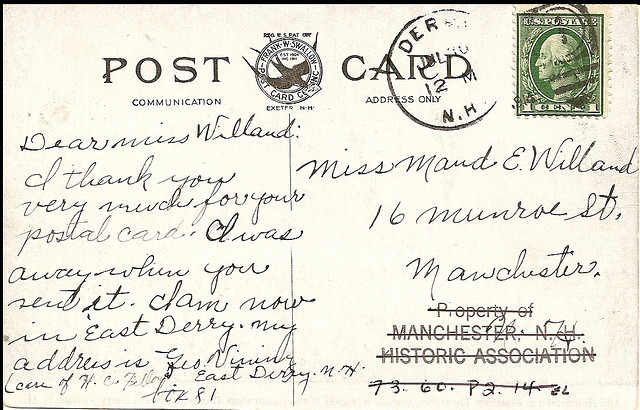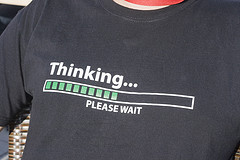|
|
|
Monday, June 16th, 2014
 Writing in cursive is considered slow and inefficient, not to mention old-fashioned, whereas computers are productivity tools. Writing in cursive is considered slow and inefficient, not to mention old-fashioned, whereas computers are productivity tools.
They help people do stuff faster and more efficiently.
They can automate repetitive work and help organize complex projects.
But like most things, computers, and now other smart devices, have a dark side.
Computers can kill creativity and thinking itself, along with social skills like empathy.
Keyboarding is a good example; it eliminates the need to write, which people see as a good thing, because they can type much faster than they can write.
But that efficiency is a double-edged sword.
Research now shows that kids learn better when they write longhand using cursive, as opposed to printing or typing.
For adults, typing may be a fast and efficient alternative to longhand, but that very efficiency may diminish our ability to process new information.
Beyond damaging the ability to learn, the inability to write cursive usually reflects an inability to read it.
While at first glance that may not seem important, a second look and you realize that it shuts you out of anything that was discussed in correspondence, first person journaling and dozens of other human interactions over centuries.
Even if Google was able to scan all the hand-written archives, they could not be read.
If you aren’t familiar with cursive, trying to read something written in it is akin to trying to read a Russian document when you don’t know the Russian alphabet.
If you don’t know cursive, find a place to learn it.
You’ll be surprisedatn the value it will add to your world.
Of course, you may be one of those people who believe that anything that predates computers and the Internet has no value.
If so, you deserve my sympathy—and my contempt.
Flickr image credit: derrypubliclibrary
Posted in Communication, Personal Growth | No Comments »
Monday, September 10th, 2012
 Are you a list maker? If so, you have a lot of company. Are you a list maker? If so, you have a lot of company.
We’re living in the era of the list, maybe even its golden age. The Web click has led to the wholesale repackaging of information into lists, which can be complex and wonderful pieces of information architecture. Our technology has imperceptibly infected us with “list thinking.”
Remember Day Timers? Those fat loose-leaf notebooks in which you organized your work, not to mention your life?
Then to-do lists migrated to PDAs and more recently to Siri, but paper is making a comeback.
I don’t find this strange because I never migrated to digital.
The reason is simple—“out of site/out of mind.”
I can write to-do lists, reading lists, all kinds of lists digitally, but they have no staying power—and it’s not just me; experts are finding the same thing.
Paper, says the productivity expert David Allen, is “in your face.” Its physical presence can be a goad to completing tasks, whereas computer files can easily be hidden and thus forgotten, he said. Some of his clients are returning to paper planners for this very reason, he added.
Further, the idea that a person can grasp the complexities of a multi-part project plan by reading it on a smartphone screen or tablet is just plain laughable.
So the next time you are chided for writing (with a pen or pencil) a to-do list, making notes (in the margins) or reading hardcopy you can email or text the above URL and tell your tormentors that you are being efficient and they might try doing the same.
Flickr image credit: Jayel Aheram
Posted in Communication, Personal Growth | No Comments »
Wednesday, May 30th, 2012
 I started to write this a couple of hours ago as a way to vent my frustrations with a couple of clients; fortunately, I cooled down in the interim, so what follows is not a rant. I started to write this a couple of hours ago as a way to vent my frustrations with a couple of clients; fortunately, I cooled down in the interim, so what follows is not a rant.
I write for many entrepreneurs, reworking executive summaries, marketing material, websites, etc., and, through discussions often help them extend and reformulate their product ideas. I enjoy it and am told that I add substantial value.
I often work on what I am told are tight deadlines, which means evenings, nights, weekends and even holidays occasionally.
And knowing how tight startup budgets can be I rarely charge for the express services—except…
The exceptions are what I call the “hurry up and wait” clients.
These are the few who talk (whine?) of tight deadlines and major penalties for missing them and then take days to reply to my questions or new drafts.
They are often the same ones who send incomplete information using “etc.” in place of the specifics they want used, which implies that I should look up the information which, for a number of reasons, I never agree to do, and forgetting delivery dates until asked—that’s usually when I find they need it in one or two days.
In a couple of instances people who knew them told me they treat all contractors the same way, since they aren’t “really employees.”
That said, here are five rules to help you get the most bang for your non-employee buck and avoid ulcers on either side.
- If someone is worth paying they merit your respect (chances are you couldn’t afford to have them in-house even if you needed their skills full-time).
- Provide them with extra-complete information, because they aren’t privy to your shared company knowledge.
- Specify a delivery date and if the project is also facing an external deadline, e.g., a business plan competition.
- Respond to questions, drafts and iterations promptly if you want your delivery date met; it is almost impossible to keep working without answers and feedback.
- Pay the bill promptly; if you need special consideration discuss it up front and make the arrangements before the work is done.
All the above is common sense and follows normal business etiquette. If you are incapable of any of them you should either rethink your non-employee useage or be prepared for the major damage you will do to your personal brand.
Flickr image credit: losmininos
Posted in Business info, Communication, Personal Growth | 1 Comment »
Thursday, November 4th, 2010
 Bosses, business coaches, academics, bloggers and many others bemoan the lack of communications skills in Gen Y, especially written communications, but they have plenty of company in preceding generations. Bosses, business coaches, academics, bloggers and many others bemoan the lack of communications skills in Gen Y, especially written communications, but they have plenty of company in preceding generations.
Not just bad writing, but opaque writing, the kind that leaves readers scratching their heads wondering what they are missing.
Of course, I shouldn’t complain, since one of my company’s most popular products is Clarity RE-writing, which involves using the fewest possible words to present even the most complex information in the most understandable way.
Who are the worst writers?
Granting that many of Gen Y don’t understand the difference between writing and texting, I find lousy writing much more offensive when it comes from those who (should) know better.
And while the more lofty their position the more offended I am, I save my greatest reaction for those old enough and senior enough to know better who work in the field—in other words, they are, or should be, professional communicators.
Charles H. Townsend, the chief executive of Condé Nast Publications, which includes Vogue, The New Yorker and Vanity Fair, is such a one. He recently sent a 500 word memo to his staff, here is a sample from it.
“…a consumer-centric business model, a holistic brand management approach and the establishment of a multi-platform, integrated sales and marketing organization.”… “To optimize brand revenue growth, we will shift responsibility for single-site, digital sales and marketing to the brand level. Publishers can now fully leverage their offerings across all platforms.”
Don’t feel badly if you aren’t sure what he is trying to say, his staff wasn’t sure, either.
If you want to write clearly here is some quick and basic guidance.
- Avoid jargon;
- shun multi-syllabic words;
- use short, simple sentences;
- pass on large blocks of text, especially on the Net;
- spell check everything; and, most importantly,
- remember that most people scan and don’t actually read.
Image credit: http://www.flickr.com/photos/nirak/2854421030/
Posted in Communication, Leadership's Future | No Comments »
Friday, May 7th, 2010
This week has been about communications, both corporate and personal, and what they tell the world beyond their words. Today is about basic ways to improve them.
Way back in 2006 I wrote Good writing fast—an oxymoron and in those four years only two things seem to have changed—writers care less and readers complain more.
It’s actually easy to make basic improvements on your writing using tools you already have. Yes, they take an extra minute or two, but consider the negative impression your writing can make will last for years.
Your writing will improve significantly just by using three simple tools
- In Word (or what ever word processing program you use) and turn on spell checker and grammar checker (skip style checker) and use them.
- Write blog comments, etc., in word and paste them where you want them.
- Set your email to spell check automatically before sending.
 But the most important tool to improve your writing is your MAP (mindset, attitude, philosophy™). You may find that you need to adjust all of them and this is as true for corporations as for individuals. But the most important tool to improve your writing is your MAP (mindset, attitude, philosophy™). You may find that you need to adjust all of them and this is as true for corporations as for individuals.
- Foremost, you must think, not only about what you want to say, but also about the effect you want to have and the image you want to project.
- You need to care; you need to own the idea that the stuff you write on the web really is people’s first impression of you and consciously decide what you want that impression to be.
- Understand that jargon, rambling or complex sentences and multi-syllabic words will not make you sound more knowledgeable or your pitch more impressive.
You must be willing to spend the extra few minutes it takes to implement the six points; once it becomes your new norm and you see the effect you’ll wonder why you didn’t do it sooner.
Flickr photo credit to: http://www.flickr.com/photos/karola/3623768629/
Posted in Business info, Communication | No Comments »
Thursday, May 6th, 2010
 We are talking about communications this week; Tuesday we looked at a sample of opaque corporate communications; today we’ll consider personal communications. We are talking about communications this week; Tuesday we looked at a sample of opaque corporate communications; today we’ll consider personal communications.
I will skip the idiocy of the tell-all approach so popular on Facebook, MySpace, etc. and focus instead on the trail of poor communications so may people leave behind as they comment their way around the Net, whether it’s a review on Yelp, comment on a business/professional/”straight” blog, profile or some other form of “personal branding.”
Let me say this in words of one syllable: How you write tells people who you are.
As I’ve written before, this isn’t just about Millennials, it applies to anybody still concerned about the impression they make.
I came across a perfect example completely by accident.
Granted it is an extreme example; the comment was left on a blog post discussing social judging skills citing research showing that children as young as three months demonstrate them. (I’m not including a link to the post because I have no interest in embarrassing the writer who used her own name.)
well i think that people say they an change a baby if they are rude or like bad you know but really the baby knows what there trying to pull on them:) i think that people say they can change peope and if they think they changed someone there wrong cause deep deep down your still that mean cruel un hearted person or caring person:)
Lots of people write all lower case, so perhaps we should ignore that. And there are many words that sound alike with totally different meanings—there and their—so should we give that a pass? Can you make sense of what the writer is saying?
What is your impression of the writer?
Would you hire her or want her on your team?
Now consider that it was written by an adult, native English speaker, who has a college degree and works in a professional capacity.
If she was a candidate you were considering and you googled her name and saw this would you hire her?
It’s unlikely she writes like this all the time, because if she did she couldn’t do her job, but when it comes to the web the usual attitude is ‘who cares’?
Your writing is like breadcrumbs left along your route on the web; they enable the world to follow you and get to know you; it is their first impression of you.
It’s up to you to decide what that impression will be.
Join me tomorrow for the basics of good breadcrumbs.
Flickr photo credit to: http://www.flickr.com/photos/jeanbaptisteparis/224566560/
Posted in Business info, Communication | No Comments »
Wednesday, May 5th, 2010
 Flickr photo credit to: http://www.flickr.com/photos/dbdbrobot/140068142/ Flickr photo credit to: http://www.flickr.com/photos/dbdbrobot/140068142/
Posted in Wordless Wednesday | No Comments »
Sunday, November 1st, 2009
 I just finished Mary Higgins Clark’s memoir. Hers is a name you see everywhere, books, TV movies and on the big screen. The memoir is a fast read, a fascinating peek into the world that shaped this master storyteller and some excellent insights on just plain living. I just finished Mary Higgins Clark’s memoir. Hers is a name you see everywhere, books, TV movies and on the big screen. The memoir is a fast read, a fascinating peek into the world that shaped this master storyteller and some excellent insights on just plain living.
“When a child comes to you wanting to share something he or she has written of sketched, be generous with our praise. If it’s a written piece, don’t talk about the spelling or the penmanship; look for creativity and applaud it. The flame of inspiration needs to be encouraged. Put a glass around that small candle and protect it from discouragement or ridicule.
I wonder if any adult—parent or teacher—realizes that young people never forgive or forget being humiliated.”
This really hit home. In high school I took a creative writing class; one assignment was to write a short screenplay from which our teacher would choose a few to critique in class.
He started with the one he thought was best and proceeded through the others. Mine was among those chosen and he tore it to pieces, not professionally, but with sarcasm and zingers. He ended the critique by asking how any student could be so arrogant as to think that the writing had any value whatsoever.
Needless to say, the so-called anonymity was a joke and everyone knew who the authors were and my humiliation was extreme. It was 35 years before I creatively wrote again, but never stories—that desire was totally dead and buried.
Higgins Clark shares two old definitions of happiness that should resonate with everyone and if they don’t then you need to take a hard look at your values.
“If you want to be happy for a year, win the lottery. If you want to be happy for life, love what you do.” and “Something to have, someone to love, and something to hope for.”
Definitely food for thought as you start gearing up for the holidays.
Finally, following up thread I started Friday and have decided to continue tomorrow, “It is not always how we act, but how we react that tells the story of our lives.”
I hope you will join me tomorrow to see why, in many cases, coping is a far more productive activity than fixing, both at work and in life.
Your comments—priceless
Don’t miss a post, subscribe via RSS or EMAIL
Image credit: Mark Coggins on flickr
Posted in Personal Development, Quotable Quotes, Reviews & Recommendations | 2 Comments »
|
 Subscribe to
Subscribe to
MAPping Company Success
About Miki 
Clarify your exec summary, website, etc.
Have a quick question or just want to chat? Feel free to write or call me at 360.335.8054
The 12 Ingredients of a Fillable Req
CheatSheet for InterviewERS
CheatSheet for InterviewEEs™
Give your mind a rest. Here are 4 quick ways to get rid of kinks, break a logjam or juice your creativity!
Creative mousing
Bubblewrap!
Animal innovation
Brain teaser
The latest disaster is here at home; donate to the East Coast recovery efforts now!
Text REDCROSS to 90999 to make a $10 donation or call 00.733.2767. $10 really really does make a difference and you'll never miss it.
And always donate what you can whenever you can
The following accept cash and in-kind donations: Doctors Without Borders, UNICEF, Red Cross, World Food Program, Save the Children
*/
?>About Miki
About KG
Clarify your exec summary, website, marketing collateral, etc.
Have a question or just want to chat @ no cost? Feel free to write
Download useful assistance now.
Entrepreneurs face difficulties that are hard for most people to imagine, let alone understand. You can find anonymous help and connections that do understand at 7 cups of tea.
Crises never end.
$10 really does make a difference and you’ll never miss it,
while $10 a month has exponential power.
Always donate what you can whenever you can.
The following accept cash and in-kind donations:
|
 Writing in cursive is considered slow and inefficient, not to mention old-fashioned, whereas computers are productivity tools.
Writing in cursive is considered slow and inefficient, not to mention old-fashioned, whereas computers are productivity tools.




 I started to write this a couple of hours ago as a way to vent my frustrations with a couple of clients; fortunately, I cooled down in the interim, so what follows is not a rant.
I started to write this a couple of hours ago as a way to vent my frustrations with a couple of clients; fortunately, I cooled down in the interim, so what follows is not a rant. Bosses, business coaches, academics, bloggers and many others bemoan the lack of communications skills in Gen Y, especially written communications, but they have plenty of company in preceding generations.
Bosses, business coaches, academics, bloggers and many others bemoan the lack of communications skills in Gen Y, especially written communications, but they have plenty of company in preceding generations. But the most important tool to improve your writing is your MAP (mindset, attitude, philosophy™). You may find that you need to adjust all of them and this is as true for corporations as for individuals.
But the most important tool to improve your writing is your MAP (mindset, attitude, philosophy™). You may find that you need to adjust all of them and this is as true for corporations as for individuals. We are talking about communications this week; Tuesday we looked at a sample of
We are talking about communications this week; Tuesday we looked at a sample of  Flickr photo credit to: http://www.flickr.com/photos/dbdbrobot/140068142/
Flickr photo credit to: http://www.flickr.com/photos/dbdbrobot/140068142/ I just finished Mary Higgins Clark’s memoir. Hers is a name you see everywhere, books, TV movies and on the big screen. The memoir is a fast read, a fascinating peek into the world that shaped this master storyteller and some excellent insights on just plain living.
I just finished Mary Higgins Clark’s memoir. Hers is a name you see everywhere, books, TV movies and on the big screen. The memoir is a fast read, a fascinating peek into the world that shaped this master storyteller and some excellent insights on just plain living.
